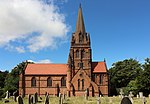Wirral Country Park

The Wirral Country Park is a country park on the Wirral Peninsula, England, lying both in the Metropolitan Borough of Wirral in the county of Merseyside and in the borough of Cheshire West & Chester in the county of Cheshire. It was the first designated country park in Britain, opening in 1973.The park is located along the Wirral Way, which follows the track bed of part of the former Birkenhead Railway route from West Kirby to Hooton. The old line, which closed in 1962, follows the estuary of the River Dee for 7 miles (11 km) between West Kirby and Parkgate. The route then heads inland, across the Wirral peninsula, to Hooton. There are two visitor centres along the Wirral Way, located near to the site of Thurstaston railway station, at Thurstaston, and at the preserved Hadlow Road railway station, in Willaston.
Excerpt from the Wikipedia article Wirral Country Park (License: CC BY-SA 3.0, Authors, Images).Wirral Country Park
Wirral Way, Wirral
Geographical coordinates (GPS) Address Nearby Places Show on map
Geographical coordinates (GPS)
| Latitude | Longitude |
|---|---|
| N 53.3425 ° | E -3.1455555555556 ° |
Address
Wirral Way
CH61 0HN Wirral
England, United Kingdom
Open on Google Maps






